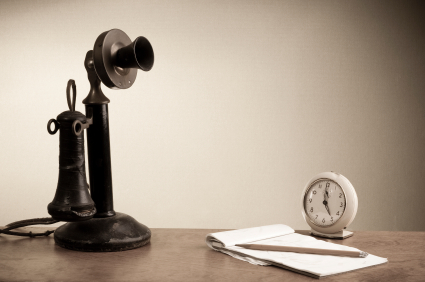 Mobile phone, cell phone, telefonino (it you’re Italian) – whatever you call it, that fancy communicator in your pocket or on your hip represents over 120 years of development, evolution and ingenuity. To trace the history of the modern mobile phone, we really need to go back to the 1870s and look at the development of the humble landline telephone.
Mobile phone, cell phone, telefonino (it you’re Italian) – whatever you call it, that fancy communicator in your pocket or on your hip represents over 120 years of development, evolution and ingenuity. To trace the history of the modern mobile phone, we really need to go back to the 1870s and look at the development of the humble landline telephone.
In 1876 Alexander Graham Bell was granted the first patent for the telephone, but the idea was touted over 30 years before and published in magazines from the 1850s. Inventors all over the world were looking for a way to convert sound to electrical signals that could be transmitted over a conductive cable and then converted back to sound again. In 1861, German inventor Johann Philipp Reis constructed and demonstrated a telephone but his attempts to have the invention published in a respected journal were met with rejection.
Bell is commonly considered to be the inventor of the telephone because he received the first patent. However, Antonio Meucci would probably been given the credit had he been able to come up with the $US10 he needed to maintain a patent caveat on his own invention that predated Bell’s by several years. The US House of Representatives recognised that in 2002. Looking back at the history of Bell’s patent, it seemed that he had a lot of luck on his side. Aside from Meucci, inventor Elisha Gray abandoned his own patent for transmitting the human voice over the telegraph as the patent office told him that there might be some interference from Bell’s patent.
Ownership of the invention of the telephone was subject to hundreds of court cases. While Bell triumphed it’s clear that the work of many scientists came together at the right time and in parallel. All those competing patents, inventions and ideas led to a period of intense invention, refinement and evolution as the world became accustomed to being able to talk over wires.
The original telephone was really just a point-to-point communications device. Of perhaps greater importance than the phone was the creation of the first telephone exchange that allowed routing between multiple telephones. The credit for that invention goes to Hungarian engineer Tivadar Puskás. That first exchange formed the basis for the communications networks that are the foundation of our modern telecommunications systems.
Eventually, even though Bell’s patent got things started, it was Thomas Edison’s design that used a graphite transmitter that gained the lion’s share of the telephone market. By the time telephone technology had stabilised in the 20th century, it became apparent that the actual telephone device was far less important than the network – something mobile phone users today understand.
Today, the telephone network spans the planet and has made the leap from analogue to digital. That’s made the operation of exchanges, so that we can connect with people all over the world, possible. The next wave of change, moving from having a dedicated telephone network to using the Internet’s infrastructure as the network is well underway with IP telephony no longer limited to ubergeeks.
MobileModo is Gizmodo Australia’s look at the rise and rise of the mobile phone, from Bell’s landline to the ubiquitous mobiles of today.